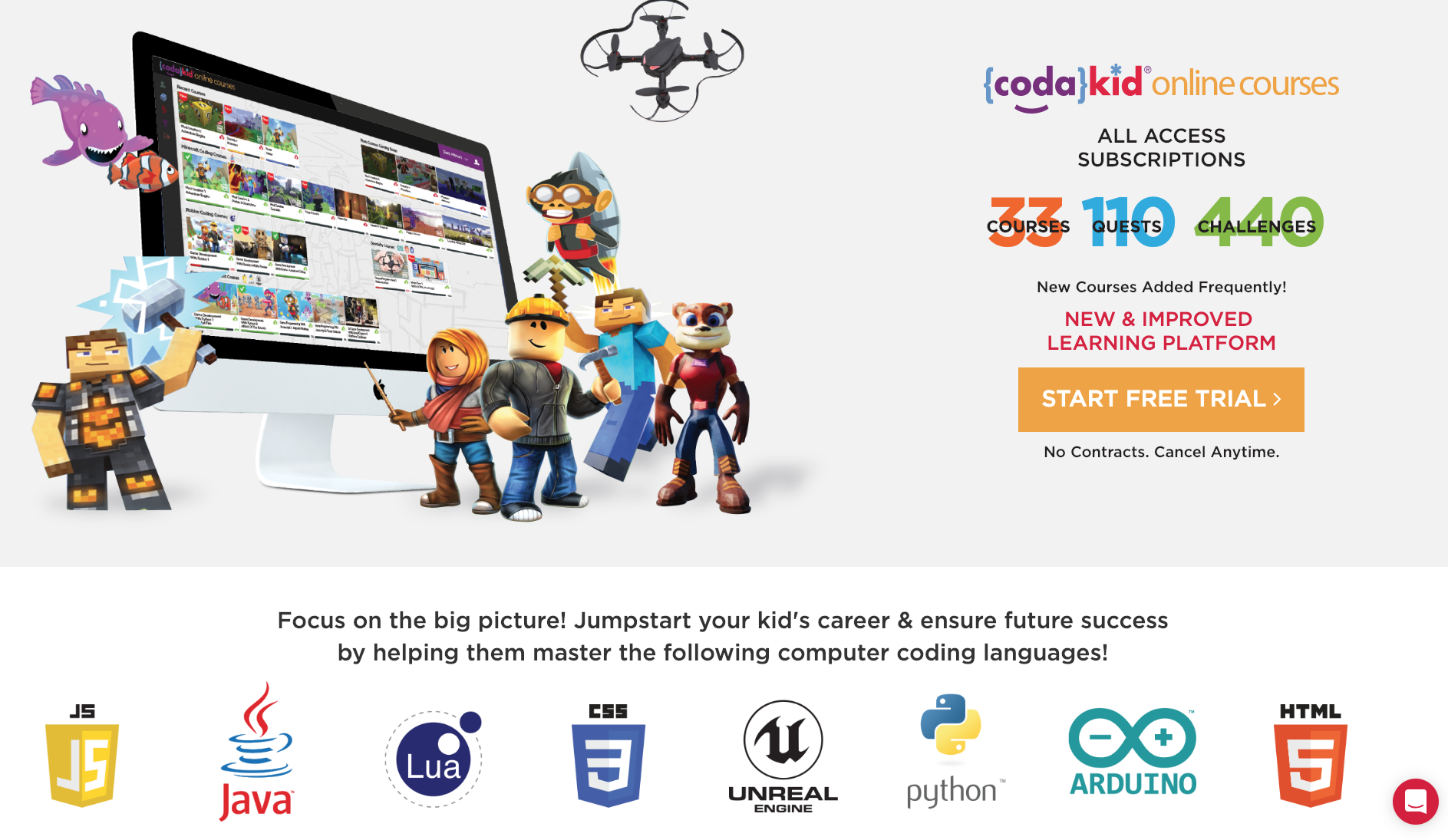Kids coding academies, coding camps, and STEM classes are cropping up in cities and towns around the globe, and the wave appears to be building.
Over 90% of parents would like to see coding taught in our schools, but only a small fraction currently teach computer science. The schools that do are limited by their staff’s ability to teach beyond simple visual block programming.
As a result, more and more parents are turning to outside resources to provide this important 21st century skill.
As the founder of a successful kids coding academy, tech camp and online curriculum licensing company, I receive several calls each week from entrepreneurs and educators asking for advice on how to get started.
In this guide, I’ll provide a number of tips that I hope will help in your planning and execution.

Table of Contents
Getting Started
Here is a basic list of essentials that you’ll need to address as you plan your kids coding academy. We will cover each of these in detail
- Decide on whether to start your own business or whether to buy a franchise
- Form a legal entity – for profit vs. non-profit, LLC, corporation, etc.
- Create a business plan
- Design the culture of your academy or camp with mission, vision, and core values (do not skip
- Plan your daily, weekly, or monthly schedule
- Select curriculum
- Put an HR plan in place to hire, train, and develop teachers or counselors
- Adhere to state regulations regarding your camps or classes
- Meet with a licensed insurance professional and determine your needs. Purchase accordingly.
You can find some good resources from organizations such as the American Camp Association which has content on everything from financial planning, HR, marketing, and more.
Forming a legal business entity
While you are in the planning stages, you’ll first need to decide what type of an organization you’ll be. In the United States, the two most common company types are non-profit 501(c)3 organizations or for-profit ones. If you plan on starting a camp in other parts of the world you’ll need to research your country, state, or provinces regulations surrounding new business formation.
If you decide to go the non-profit route in your country, you will need to apply for tex exempt status. n the US, the most common non-profit organization is a 501(c)3. You can apply for your own 501(c)3 or piggyback on an existing 501(c)3 for the fastest path to market.
As coding for underprivileged youth is a high priority for many charitable foundations, you stand a good chance of finding funding if you focus on this segment and can put together a solid business plan. Fundraising is hard work, and be prepared to spend long hours on this activity.
Another bonus in forming a non-profit is that you will also find willing partners in schools who will often let you use their facilities free of charge.
If you decide to start a for-profit kids coding camp, you will need to set up your organizational type (in the United States, the most common types are LLC or Corporation), and create a business plan that will help you establish a high quality camp.
If you plan to bootstrap your startup with your own funds, you will have more flexibility as to entity type. If you plan on raising capital, your partners will generally require you to organize as a corporation.
Full disclosure: This guide is not designed to provide legal advice but just some general observations that I’ve witnessed in my nearly 20 years as an entrepreneur and as the founder of a kids coding academy and camp. Always consult with a reputable attorney when setting up your organization to make sure that you are doing everything by the books.

Starting your own Company vs Franchising
If you decide to go the for-profit route, one decision you’ll need to consider is whether or not you’d like to start your organization from the ground up, whether you would like to purchase a franchise, or whether you’d like to partner with an existing organization that runs camps in other areas. There are several factors to consider when making these decisions.
Launching your own company
Starting your own can seem daunting, but the thrill of building something from the ground up, placing your stamp on the brand, and bringing your concept to fruition is a thrilling experience for those who enjoy entrepreneurship.
It is also risky, expensive, and along the way you will likely make many costly mistakes that a franchise partner may be able to help you avoid.
You’ll need to get a business license, research and adhere to camp licensing requirements in some states, buy the right insurance, create or license curriculum, create marketing assets, create operational processes and procedures, create training materials, hire staff, handle payroll, and more.
The benefits of running your own operation are numerous. You can operate in any geographical territory you wish, you won’t have to pay costly franchise fees and you get to keep everything that you make.
Franchising
Franchising takes some of the guesswork out of launching a coding camp, and especially if you are new to starting a business, it can be a good decision.
As Jeff Hughes, CEO of LevelUP Kids, an international kids coding franchise put it: “Franchising allows you to launch your business quickly and to leverage the branding, curriculum, marketing expertise, and operational support of an experienced partner who is invested in your success.”
When you invest in the right franchise, you get a proven model that will give you a number of important advantages in the marketplace.
Some franchises will require you to rent a space, and will help you with location identification and interior design.
The downside of franchising is that you will be restricted to certain territories, you will have to pay a large one-time franchise fee, you’ll need to pay ongoing monthly franchise fees, and there will be some controls set on what you can do with the brand.

Creating a Business Plan
Writing a business plan is a smart idea, and unless you plan on pitching it to investors, it can be something simple that works for you. I have always written business plans for every business that I’ve ever started, and I continue to refer back to them, add updates to certain sections, and make them useful even years after the launch of a new business.
Here is an outline that covers most of the import areas:
1. Executive Summary
-
-
- “The Problem” Summary
- “Our Solution” Summary
- Market Summary
- Competition
- Why Us?
- Forecast
- Financial Highlights by Year [chart]
- Financing Needed
-
2. The Opportunity
-
-
- Problem & Solution
-
- Problem Worth Solving
- Our Solution
-
- Target Market
- Competition
- Current Alternatives
- Our Advantages
- Problem & Solution
-
3. Plan of Execution
-
-
- Marketing & Sales
- Marketing Plan
- Sales Plan
- Operations
- Locations & Facilities
- Technology
- Equipment & Tools
- Safety plan
- Milestones & Metrics
- Milestones Table
- Key Metrics
- Marketing & Sales
-
4. The Company
-
-
- Overview
- Team
- Management Team
- Advisors
-
5. Financial Plan
-
-
- Forecast
-
-
-
-
- Key Assumptions
- Revenue by Month [chart]
- Expenses by Month [chart]
- Net Profit (or Loss) by Year [chart]
- Financing
- Use of Funds
- Sources of Funds
-
-
-
-
- Statements
- Projected Profit & Loss
- Projected Balance Sheet
- Projected Cash Flow Statement
- Statements
-
6. Appendix
-
-
- Monthly Financial Forecasts
- Additional Documentation
-
Writing a business plan takes time and energy, but will serve as an invaluable roadmap for you.
In particular, make sure to create very detailed financial plan, as this will be one of the most critical components making sure that your academy can survive the challenging early days when you are trying to get your name out there.
If you are new to financial planning and modeling, there are many resources out there to help you. One of our favorites is SCORE, and we are including a link to helpful template that can help you with financial projections. SCORE additionally has free mentoring available in many cities.

Understanding your competition
Researching your competition is one of the first things that you should do, regardless of the model you employ. You can quickly discover which companies are market leaders in your area, and who is not – and if you employ some basic business intelligence strategies (only ethical ones of course), you can quickly find the reasons for their success or failure.
First, I suggest that you make a list of your competitors and create a Google Sheets outline that allows you to understand key things about them at a glance. In addition to their URL, things that I jot down are the following:
- Brand strengths and competitive advantages (you can formulate this by visiting their website, studying their operations, researching their curricula, checking their online reviews, and studying their marketing strategies).
- Brand weaknesses
- Pricing
- Program types (camps, classes, online, drop-in, after school, parents’ night out, workshops)
- Growth strategy (You can glean this info by checking out the site and looking for basic clues. For example, are they selling franchises? Does their Careers page give you any clues about what they are focusing on and where they are going?)
If you competing against with an established competitor that has excellent brand communication, a solid program, and great reviews, you will need to look for programmatic or geographical niches where you may be able to find success.
It is always best to not compete solely on price unless you are in one of those rare situations where a competitor is gouging the market.
Choosing a brand name
If you plan on launching your own academy or camp, you’ll need to come up with a name for your organization.
Try to come up with a list of aspirational and sticky brand names that are easy to recall, that will not risk brand confusion with existing brands, and that have available URLs. This process is often more complicated than it seems.
I often start by starting a Google sheet and then creating columns for name, available URLs, and notes. While .com extensions are preferable, it is increasingly increasingly to find available ones. In this case, .net and .io extensions can work perfectly well.
Next, visit the TESS database on uspto.gov. You can do a basic word search for your brand name and see if any Live registrations exist. If they exist and are in your category or something related, you will likely need to look for another term.
If the brand name is used for a product or service that is completely unrelated, you might be in luck. You’ll also need to search similar sounding terms with different spellings to see if there are other Live registrations. One other thing that can cause your registration to be declined by the USPTO is potential for brand confusion.
While it is not necessary to register your mark with the USPTO, it is highly recommended. If you end up launching a company, invest in its branding, and then receive a cease and desist letter a few years down the road, you will experience a lot of stress and aggravation.
If you have funds to do this, you can always hire an experienced patent and trademark attorney to help with this process. They usually have fixed rate packages that include research and registration.
Finding a Location
If you plan on a longer term rental for a kids coding school, you’ll want to select an area with a high density of families with kids. The closer to schools you are the better, and you may find that you’ll develop relationships with many of these schools.
If you plan on renting a short term space for your kids coding camp, you’ll want to look for locations in good neighborhoods and again with lots of families and schools. Most rental locations will require a longer term lease, so you’ll want to focus your attention on places that are accustomed to short term rentals such as schools, community centers, co-working spaces, or tech incubators.
As cash flow is generally a challenge in the early days, I recommend that you work out a revenue sharing arrangement with these places – where they earn a percentage of every camp that you sell. This way, you won’t be on the hook with a fixed rental agreement.
Many schools will be eager to rent space during the slow summer months, and they will even be willing partners in sending flyers home to their families, including you in school newsletters, and allowing you to attend parent nights.
Program Types
Most kids coding academies do one or several of the following to generate revenue:
- Offer after school or weekend classes at their centers
- Run summer, winter, or spring break camps
- Hold classes or camps at schools or community centers
- Hold “Parents Night Out” workshops or Code-a-thons
- Do 1:1 tutoring at their centers or in-home
Recently we’ve noticed that a popular model is to offer a “drop-in” program where kids can take self-paced courses with a teacher supervising the sessions at academy or center. Parents purchase monthly packages that allow students to come for 4 or 8 hours per month on any day that works for them.

Marketing
Your marketing will likely be one of the most challenging parts of your job while you are building your brand.
Here are some of the most effective and inexpensive ways that we’ve found to market our camps and classes:
- On Page Search Engine Optimization (SEO)
- Blogging with an SEO focus
- Email lead capture through free content on your website or landing pages.
- Facebook and Instagram retargeting ad campaigns for visitors
- Attending Camp fairs
- Postcard racks in point of sale locations where families shop or eat
- Yard signs (be careful with this as they are illegal in many cities)
- Sending home camp and class flyers with partner schools
- Hanging fence banners at partner schools
- Sending e-flyers through services like Peachjar
- Using website chatbots to offer free resources or offers in return for an email address
- Writing guest blogs for local portals that have a kids activities focus
If possible, we recommend advertising six months or more before your launch. You should make building an email list and SEO your top priority during these intro months.
A proven, predictable way to gather email leads should be your top priority. Whenver you attend events, make sure you have raffles that require an email address for entry.
PR
Local media love writing articles and shooting video segments on new businesses opening in their cities. Kids coding stories are often seen as “feel-good”, evergreen stories that viewers love to read about or watch.
You often don’t need to hire a PR agency in your first year, as you can find the names of editors and reporters and pitch your story directly.
When pitching, be short and succinct. Clearly explain what makes your academy unique, and don’t be afraid to include personal anecdotes.
You can also try submitting story ideas to the main editorial desk. Media outlets are always looking for fresh, interesting content, and they may respond if your pitch is interesting enough.
In our first year, I was able to land several stories in local newspapers and get us on air for TV broadcasts, all by writing reporters directly.
As you grow, hiring a PR firm can make sense, as they have connections at major publications and can get you bigger stories.
As Melissa DiGianfilippo, co-founder of PR and Advertising firm Serendipit Consulting put it: “Earned media through PR can easily generate as much or more traffic than paid ads, and can position you as a thought leader in your industry.”
Computer and Equipment Options
There are several different ways that you can handle equipping your camps and classes with computers.
Most kids coding academies provide kids computers they can work with during camp. By having computers onsite before camp, you can ensure consistency and quality, and make sure that day one of your coding camp runs smoothly.
If you choose to obtain your own computers, you can purchase them, lease them, or even rent them.
Another option is that you can require camp participants to bring their own laptops. If this is the route you take, you’ll want to be very clear about hardware requirements and if you plan on installing software as part of your camp curriculum you may want to have parents to do as much software installation as possible from home prior to camp.
The weakness of this model is that you will inevitably encounter lots of tech issues, as many families will inadvertently send kids to camp with computers that have out of date software, be unaware of malware issues, or worse. There will likely be a lot of wasted time on day one addressing these issues which can impede progress.
Selecting Curriculum
Your course offerings are one of the most important decisions you’;ll need to make.
This decision will depend greatly on what type of coding academy or camp you decide to launch, your staff expertise, computer specs, and instructional style.
If you would like to launch a sustainable academy that gets great reviews and word of mouth referrals, you will need to make sure that your classes and camps are really fun, highly educational, and that they provide something better than your competition.
You can tell parents how great your curriculum is until you are blue in the face, but if the kids don’t enjoy it, they will lose interest and persuade their parents to drop your program.
Regarding curriculum, you generally have two choices: 1. Develop your own OR 2. License courses from 3rd party providers.
Developing your own is costly, time-consuming, and will often require code updates which can get expensive.
Licensing curriculum can get you up and running quickly, save you time and hassle, and allow you to focus on the most important part of startup life – acquiring customers.
CodaKid’s award-winning curriculum is one example of a multi-year, progressive coding curriculum that begins with Scratch 3.0 and that then takes students down a variety of paths including Minecraft Modding with Java, Roblox Game DEvelopment with Lua, Game Programming with Python, Web Development with HTML/CSS, and more.

Starting Operations
Starting operations is the most exciting part of the process. It is the culmination of months of hard work and planning, and is the time when the rubber finally meets the road.
When we started, we began with a series of weekend workshops so we could gain experience and work out the kinks in our model. We offered a series of Parents’ Night Out Code-a-thons and got the word out through local publications and some local deal sites. While we didn’t make much during this first month, it allowed us to learn the ropes.
We highly recommend using surveys as frequently as possible during your first few months so you can learn what’s working and what’s not. Customers will genuinely appreciate that you care about their opinion, and when they see changes implemented in response to their suggestions, they will often become long term customers.
Questions?
If you have questions about starting a kids coding academy, please feel free to leave a comment below and we’ll be happy to get back with you!
We hope that you’ve enjoyed this guide!


















